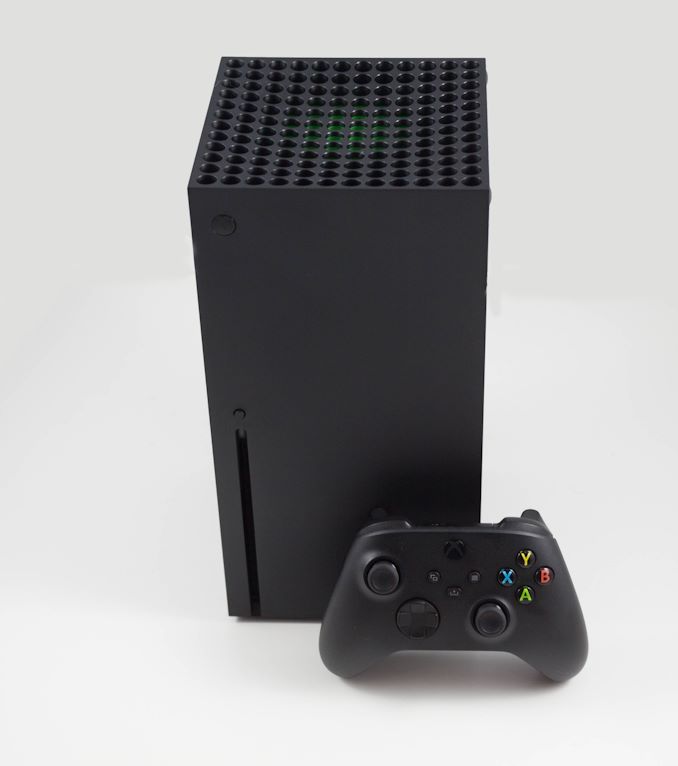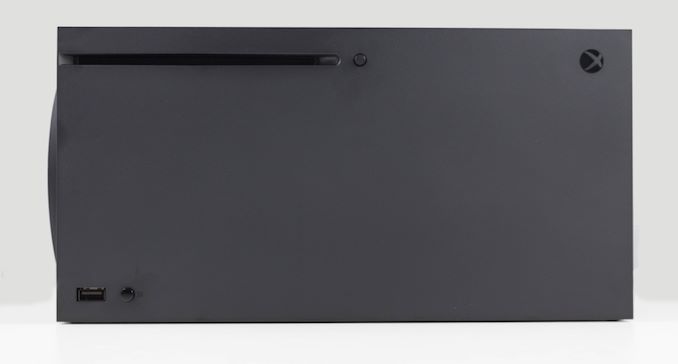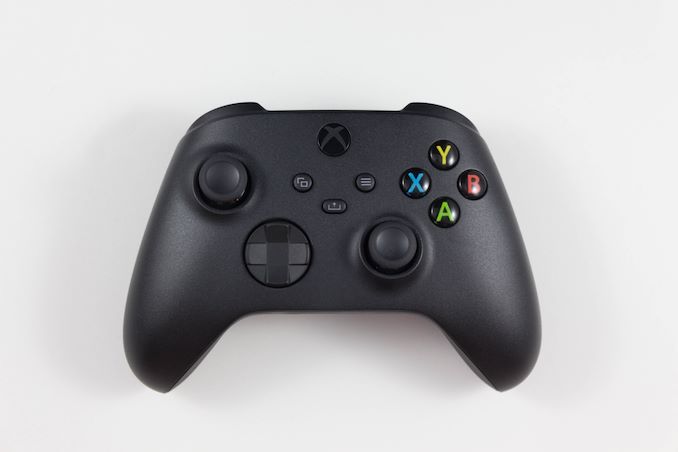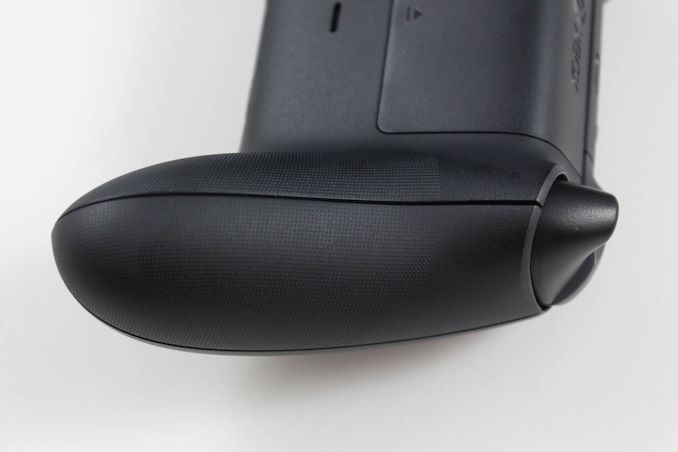The Xbox Series X Review: Ushering In The Next Generation of Game Consoles
by Brett Howse on November 5, 2020 9:00 AM ESTThe Xbox Series X Design
Now that we have gone over what is inside, let us chat about what is happening on the outside. This current next-gen console launches brought about designs which are quite different than those before. Microsoft’s Xbox Series S does offer a more traditional console look to it, but the Xbox Series X, in its all matte black finish, is decidedly untraditional.
First, the Xbox Series X is designed to ideally be placed upright, as in standing vertically. Now, to be sure, there are rubber feet which allow the console to sit horizontally, however there are small tells that this isn't Microsoft's preferred position, and as such the console looks a bit odd on its side. The Xbox icon on the power button would be rotated if placed on its side, much like the Xbox Series S power button is designed for a horizontal arrangement. The Series X dimensions feel a bit off when the console is laid horizontally, with it being quite tall, but very shallow looking. There is no one saying it won’t work on its side, and Microsoft including rubber feet on the console means that they also have no issues with it being kept horizontally, but from a pure aesthetics view, it looks a bit more proper when standing up.
That is a shame for anyone that wants to place the Xbox in a rack of electronics. The matte black finish works well in this scenario since it would match other AV equipment, but most AV shelves are not designed for the vertical Xbox, so you would have to put it on its side, and be forced to face the cringe-worthy look of the sideways power button for years to come.
The main reason for the square vertical design is of course heat. The Xbox Series X is the most powerful console built to date. It's also one of the most power-hungry. Despite the use of 7 nm TSMC transistors, packing 12 TFLOPS of GPU along with 16 GB of GDDR6 and an 8-core Zen 2 processor means that there is a significant amount of thermals to deal with. We will go into how well it handles the thermal requirements shortly, but clearly the design team wanted a console that was first and foremost cool and quiet, so they've designed around that.
The aesthetics are very subdued, with not a lot of defining features of the design when looking from the front, other than the slot-loading UHD Blu-Ray drive. The power button is on the left, and lights up in use, but there are no flashy lights otherwise.
As much as it may seem silly to RGB all the things, it might have been nice to see some Xbox green LEDs to give a soft glow out of the top of the unit, with the option to disable them, because otherwise there is not a lot to see. The top of the unit does feature a wide grille for hot air to escape, and it does feature some subtle green coloring, but that coloring can not be seen in a dark room.
The matte finish looks great, but be warned: it is a fingerprint magnet.
The sides of the Series X are completely devoid of anything. The rear does have a bit more venting for air intake, along with the bottom which also features a podium to raise the unit slightly, and of course on the back are the main AV connectors, Ethernet, USB Type-A, and the storage expansion slot.
Xbox Series X Controller – Subtly updated
For this generation, Sony has significantly updated their controller, but Microsoft took the safer approach. Microsoft’s Xbox team seems very serious about blurring the generational lines, and introducing a new controller, especially when the existing one was so well received, may have alienated some fans. Also, it means all Xbox One controllers will work with the new system, which is great as people may have purchased custom controllers, or one of the Elite controllers.
The new controller features the standard Xbox Wi-Fi Direct connection that has been around since Xbox One, although with Dynamic Latency Input, which polls the controller more often for reduced lag. Microsoft added Bluetooth support to the Xbox One controller as a mid-cycle refresh, and for the new generation they are expanding that to include Bluetooth Low Energy, meaning it will be compatible with more devices, and be easier to pair.
Physically, all the changes to the controller are very subtle. The most noticeable change is that there is now a new share button located right in the middle of the controller. When Xbox One launched, sharing was expected to be done via Kinect, but as that system died a painful death, it was replaced by being able to share by pressing the Xbox button, then sharing. It was a somewhat painful process. The new share button allows for screenshots by tapping the button, or video clips by holding the button.
The controller continues to utilize AA batteries, and Microsoft is all-too-happy to sell a rechargeable kit as an optional accessory. The controller now can charge via USB Type-C, which is great to see, as most phones have made the switch as well, so having a Type-C charger handy is not that unlikely. If you were someone who purchased the Chatpad, it is also still possible to use on the new controller, which like the previous generation, also has a 3.5 mm audio jack on the bottom for a headset connection.
The controller finish has also been tweaked, with a slight texture on the controller arms now, providing less of a chance of the controller slipping when hands get sweaty. The same texture is also on the triggers.
The D-pad has also been overhauled, moving from having just the cross, to now being a full circle with a raised cross, which should help tremendously on games that expect you to press in the midpoints.
The new controller feels great with the new textures, but most definitely is not a departure from the Xbox One controller in most respects. This was not an accident, since the Xbox One controller was quite good, and with the heavy emphasis on backwards compatibility, keeping the same basic controller design makes a lot of sense. That being said, it does not feel next gen because it is more or less the same as the previous design.
If you were a fan of the Xbox Design lab, where you could design a custom controller, it is currently not available as they ramp up for the new controller, so look for it to be back in 2021.














68 Comments
View All Comments
eastcoast_pete - Saturday, November 7, 2020 - link
You're correct, and Brandon was outstanding in this movie (by Elia Kazan, I believe). Thought Stallone did borrow that line for Rocky, but it's been a while that I watched it. That being said, the "S" is at risk of being the bum among consoles, and the fact that it's readily available for pre-order suggests it's not rocking many boats out there.flyingpants265 - Friday, November 6, 2020 - link
One or two of the cores are doing things not related to games.flyingpants265 - Friday, November 6, 2020 - link
What exactly is the point of the Series S? The whole point of consoles is that they're standardizedandrewaggb - Friday, November 6, 2020 - link
The trend started with the ps4 pro and xbox one x. They're still fairly standardized, same peripherals, same cpu, same gpu archicture, same software. Series S is just for 1080p only and will probably have somewhat lower quality textures because it has less ram.Shlong - Monday, November 9, 2020 - link
The Series S also doesn't have updated graphics for backward compatibility games. The graphical updates for Xbox One games will show up on Series X but not S.cmdrdredd - Monday, November 9, 2020 - link
That went out the window a while back. Now it's just a brand, the Xbox. All games using smart delivery work on any Xbox One or Series console and will use the appropriate settings and resolution for that console. Not unlike graphics settings in your PC. I could ask what the point of a RTX3070 is and the answer is the same. A lower power and cheaper alternative that is good enough for a lower resolution.eastcoast_pete - Friday, November 6, 2020 - link
Thanks for the first look/review, Brett! Question: Did you have a chance to see just how fast the USB 3.1 connection is when a. Used with an external SSD or b. a regular 7200 rpm HDD. Especially interested in getting an idea how fast or slow it is to transfer some of the games you tested back into the built-in SSD. If you haven't tested it but still have the unit, can you try it? Thanks!Brett Howse - Saturday, November 7, 2020 - link
Thanks for the question. I don't actually have a USB SSD drive to test this. I do have a slower USB HDD but I think it would end up being the bottleneck and would give unreliable results. I think whether this is worth it for you is whether you have fast internet or not.I'll still try the USB HDD this weekend and just see how it goes and let you know.
eastcoast_pete - Saturday, November 7, 2020 - link
Thanks Brett, even a regular HDD will give an initial idea. Regarding an external SSD: Maybe someone else at AT has an external SSD they can lend you? With the current pricing for the proprietary add-on SSD, a half-priced external SSD connected by USB 3.1 is an interesting alternative. Assuming the Series X supports about 350 - 400 MB/second over USB, I'd probably get a 1TB external SSD and keep an external 8 TB HDD for "cold storage".Brett Howse - Saturday, November 7, 2020 - link
Just so you are clear on this, any USB connected drive is not capable of being used for Series X|S games. It can be used for storage only. To play the new games they have to be on internal storage or on the Seagate storage drive. You'd have to shuffle games around if you want to keep them on USB.